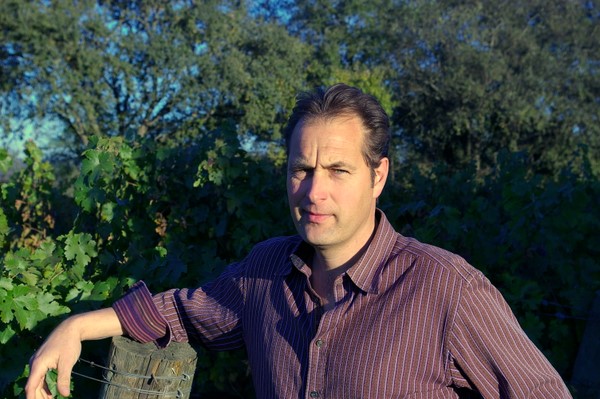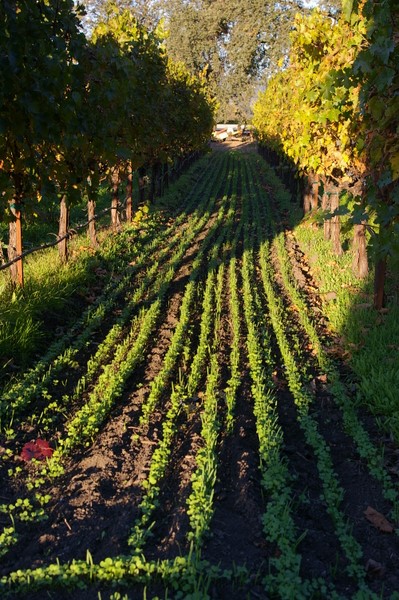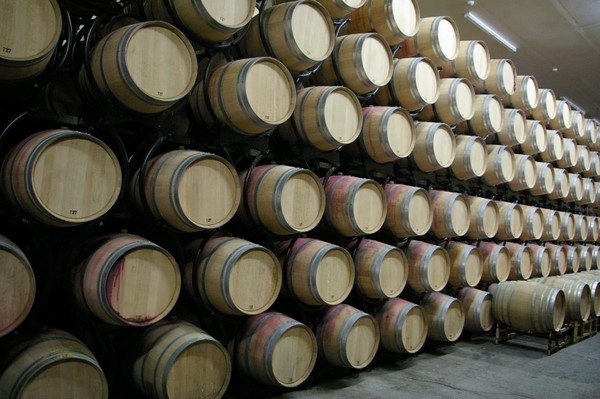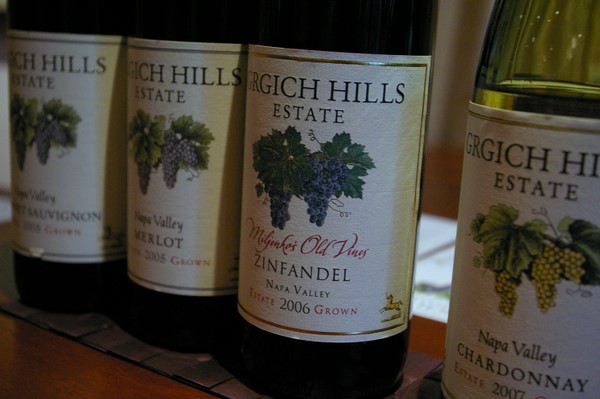|
Grgich
Hills
Visiting California's Napa Valley, part 8
Website:
www.grgich.com

Ivo Jeramaz
Grgich
Hills was started by Croatian-born winemaker Miljenko Grgić
(whose name was anglicised as Mike Grgich when he moved to Canada in
the 1950s) in 1977. Mike had previously been winemaker for Robert
Mondavi and Château Montelena – indeed, it was Mike who made the
famous Château 1973 Montelena Chardonnay that triumphed in the
Judgement of Paris tasting in 1976.
I met
with Mike’s grandnephew, Ivo Jeramaz, who began working with the
winery in 1986 and is now the general manager. Ivo has taken the
winery in the direction of biodynamics. ‘Mike grew up in Croatia
and worked vineyards with his grandfather,’ says Ivo. ‘It was
natural farming, with no chemicals, so he grew up understanding
natural farming.’

Cover crop
‘In
2000 I started reading about biodynamics and was interested. I
received an invitation from the Benzinger family to attend a seminar
with Nicolas Joly. It really opened my eyes.’ So Ivo went to Mike
to try to convince him to turn 5 acres over to biodynamics. ‘It
took me three minutes to convince him, and instead of 5 acres, he
said why not use 20?’ Ivo recalls.
Currently,
Grgich have five different vineyards in Napa with 370 acres in all.
They started out in Yountville, next to Dominus. The vineyard there,
planted in 1959 was dying from virus. There were very low yields and
the grapes struggled to ripen. ‘We’d be lucky to get to 22 Brix,
and we had pink grapes,’ says Ivo. After three years of biodynamic
treatments, the vineyard had rebounded dramatically, and it now
makes their most expensive Cabernet Sauvignon. ‘There are fewer
red leaves and the vineyard now wants to go to 30 Brix.’

Barrels on an oxo-line system
Ivo
says that he cares about organic matter in the vineyard, and that
humus in the soil is the crux of farming. They follow the vineyard
soils by digging pits, and have seen much better structure in the
biodynamically farmed soils.
Virus
is a big problem in the Napa. ‘90% of the Napa Valley was
replanted in the early 1990s,’ says Ivo. ‘We are only talking 18
years or less and vineyards have been pulled. Thousands of acres
every year are pulled. For example, the grower over the road
replanted everything on resistant rootstock between 1991 and 1994,
and everything is dying. The professors from University of
California Davis say that it is leaf roll virus. Why now? Why not 20
years ago? We love to blame bugs.’
Ivo
continues: ‘We believe that they are looking in the wrong place.
We think the problem is chemical farming. After 10–15 years the
vines lose their natural ability to fight pests.’ He adds, ‘The
plants can’t be diseased; the soil is diseased. There is no life
in the soils.’
‘In
Carneros we have a 100 acre vineyard. When we started planting in
1989 we used AXR1 rootstock.’ This was when phylloxera hit vines
on this rootstock and so they didn’t fertilize and only irrigated
occasionally, in long bursts. The roots grew further and reached
sand. In 1992 they interplanted, shortening the cordon and making
room for more plants. The expectation was that the AXR1-planted
vines would die, but they didn’t. Now this vineyard is 20 years
old, producing great Chardonnay. AXR1 is supposed to be dead, but it
is still producing. ‘How is that vineyard alive?’ asks Ivo. ‘It
is the farming that will determine the health of the plants and how
long they live.’
‘We
believe that biodynamic farming is the only way forward. Wine can be
made like coca cola. That’s OK, but at the same time it can be a
piece of art. I believe that wines are pieces of art: something that
provokes feelings in you. In order to create that wine the only way
forward is biodynamics: this is the only way you can achieve a sense
of place and uniqueness.’
He
thinks that compost is vital. ‘We make over 2000 tons of compost,
using organic cows and straw from Sonoma.’ Three tons are applied
per acre per year. ‘As soon as we harvest grapes we put compost
in, by ploughing.’ One row is cultivated and the next row is sown
to cover crop. It takes 10–11 months to make good compost.
According to Ivo, the biodynamic preparations are ‘like seasoning
on food: they restore vitality.’ They guide the elements into
proper relationship. Grgich grow all the plants necessary and make
their own preparations. ‘The peasants of 100 years ago had wisdom.’
‘A
challenge in vineyards is that they are a monoculture, so we seed 10
different cover crop species,’ he says. ‘We are combating pests
by biodiversity.’ Some of this cover crop, which can be a metre
high by March, is ploughed under as a green manure.
‘One
intangible benefit of biodynamics is the satisfaction I get from
doing this. It has changed my life: it is a hobby, not work,’ says
Ivo. ‘It is intuitive farming, just like raising kids.’
What
does biodynamics do to the wines? Acidity levels have risen at the
same Brix levels. For example, Sauvignon at 14% alcohol has 7.1 g
acidity. ’20 years ago we ordered hundreds of pounds of tartaric
acid, and had to add 2–3 g/litre to get good acidity. Now we get
good acidity.’ He says that in Napa it is impossible to get good
Cabernet at 13% alcohol. But he wants to achieve supple, soft
tannins without extreme ripeness. Most Cabernets are 15–15.5%
alcohol, but he’s found that he can achieve this with a degree
less alcohol from biodynamic vineyards.
‘For
us, sameness is a sin. We want uniqueness, typicity and a sense of
place.’

THE
WINES
Grgich
Hills Napa Valley Fumé Blanc 2008
Tight and mineral with some reductive notes. Grassy with some
herbal character, and a distinctive minerality. 89/100
Grgich
Hills Chardonnay 2007
A blend of Carneros and Napa Valley fruit, with no malolactic.
Bright fruity nose with a mineral edge and some herby notes. The
palate is savoury and nutty with lovely texture and balance. 91/100
Grgich
Hills Chardonnay Carneros
Selection 2006
This is a single block with the best clone (Wente), from 20 year
old vines. Complex nutty nose with intense notes of peach, pear and
figs. Restrained yet rich. The palate is textured with a mineral
edge to the bold fruit. Hints of nuttiness. 92/100
Grgich
Hills Zinfandel 2006
Intense, berryish nose showing fresh cherry, plum and raspberry
notes. The palate shows bright berry fruits with a savoury edge.
Restrained and delicious. 88/100
Grgich
Hills Merlot 2005
Focused, bright berryish nose. The palate has savoury, spicy,
mineral fruit with grippy tannins. A focused, fresh wine with
vibrant fruit. 88/100
Grgich
Hills Cabernet Sauvignon 2005
From Yountville and Rutherford. Nicely assertive, mineral,
berryish nose. The palate is juicy and bright with a savoury mineral
edge to the fresh berry fruits. 89/100
Grgich
Hills Yountville Selection Cabernet Sauvignon 2005
From a 50 year old block. Dense, firm, spicy wine with
concentrated blackberry and blackcurrant fruit. Lovely density and
savoury tannic structure. A primary wine with real presence. 93/100
Grgich
Hills Miljenko’s Old Vines Zinfandel 2006
From 110 year old vines; 15.9% alcohol. Intense, sweet, well
defined berry fruit on the nose. Taut and quite complex. The palate
has lovely concentration with intense red fruits and some spicy
structure. Carries the high alcohol well. 92/100
Grgich
Hills Miljenko’s Vineyard Petite Syrah 2005
14.9% alcohol. Powerful and intense with dense, firm tannic
fruit. It’s amazingly tannic with firm structure and lovely red
and black fruits. 92/100
NAPA
VALLEY SERIES
 Photos
from Napa Valley Photos
from Napa Valley
 Part
1, Cain Part
1, Cain
 Part 2, Schramsberg Part 2, Schramsberg
 Part 3, Corison Part 3, Corison
 Part
4, Saintsbury Part
4, Saintsbury
 Part
5, Lagier Meredith Part
5, Lagier Meredith
 Part
6, Trefethen Part
6, Trefethen
 Part
7, Trinchero Part
7, Trinchero
 Part
8, Grgich Hills Part
8, Grgich Hills
 Part
9, Cakebread Part
9, Cakebread
Wines
tasted as 11/09
Find these wines with wine-searcher.com
Back
to top
|

